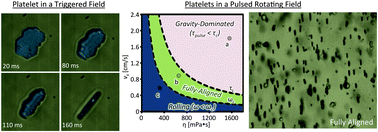Temporal response of magnetically labeled platelets under dynamic magnetic fields†
Abstract
Magnetically responsive anisotropic particles can be used as sensors, autonomous moving parts, micromixers, switches and mechanical reinforcing elements of controllable orientation. These multiple functionalities have motivated the investigation of models to describe the behavior of such particles under magnetic fields that change in time and space. In this paper, we develop a dynamic model describing the alignment of magnetically labeled platelets under external magnetic fields with arbitrary spatial-temporal patterns. We show experimentally that this model accurately predicts the alignment dynamics of isolated platelets in media exhibiting a range of viscosities. We further extend the model to describe the rich phase behavior exhibited by ultra-high-magnetic-responsive platelets subjected to the spatial-temporal magnetic field pattern generated by a translating solenoid. The dynamic response of platelets in fluids of different viscosities is shown to change from rolling to fully aligned to gravity-dominated states as the translation speed of the magnetic source is increased. The proposed theoretical framework provides a powerful means to predict the dynamic response of anisotropic particles under a variety of applied magnetic fields.


 Please wait while we load your content...
Please wait while we load your content...